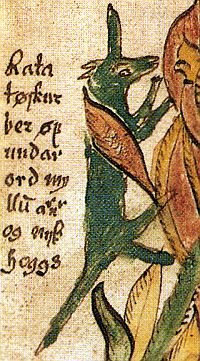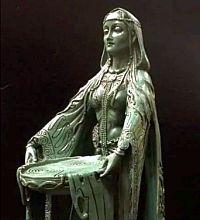Wikipedia
R.H. Allen:
Star Names
Ian Ridpath:
Star Tales
Universe Guide
Sea and Sky:
Constellations
IAU
Map
NASA:
Constellations
|
Wikipedia |
R.H. Allen: Star Names |
Ian Ridpath: Star Tales |
Universe Guide |
Sea and Sky: Constellations |
IAU Map |
NASA: Constellations |


|
|
CassiopeiaStar Lore |
|


| Cassiopeia is a bright constellation in the northern hemisphere. It is one of the 48 original Ptolemaic Constellations. |


|
Ancient Babylon
In Babylon, Cassiopeia, together with a number of stars of Andromeda was part of the
Babylonian constellation Stag.
|
  Stag constellation drawn by the author.
Stag constellation drawn by the author.
|
 Sources: J.H. Rogers: Origins of the ancient constellations, Gavin White: A brief guide to the Babylonian constellations |


|
|
Ancient Greece
The Greek legend of Cassiopeia, Andromeda and
Perseus inspired hundreds of plays, poems, novels,
operas, songs and paintings and unites no less than seven classic Greek
constellations: Andromeda,
Perseus,
Cassiopeia,
Cepheus,
Pisces,
Cetus and
Pegasus
(eight including the now obsolete Caput Medusae).
|
 Cassiopeia punished
Cassiopeia punishedPoeticon Astronomicon, 1482
|

 Cassiopeia with a mirror
Cassiopeia with a mirrormargheritacampaniolo.it |
 Cassiopeia with a palm branch
Cassiopeia with a palm branchUrania's Mirror, 1824 |
 Cassiopeia on her throne
Cassiopeia on her throneLeiden Aratea, 816 AD |



|
Europe
|

|
Norse Mythology
Richard Denning identified Cassiopeia as
Ratatoskr.
|
 Ratatoskr
Ratatoskr17th-century Icelandic manuscript. Sources: Wikipedia |


|
|
Welsh Mythology
The traditional Welsh name for Cassiopeia is Llys Dôn, The Court of Dôn.
|
 Celtic mother goddess
celticjackalope.com
Celtic mother goddess
celticjackalope.com
|



|
Arctic
|
 Reindeer;
juniqe.com
Reindeer;
juniqe.com
|



|
Middle East and Asia
|

|
|
aydi ath-thuraya - the Hands of Thuraya
Before Abd al-Rahman al-Sufi and other Arabic astronomers adopted
Ptolemy's constellations, people on the
Arabian Peninsula had their own way to navigate the sky, creating constellations like Lam, Ostriches and
Vulture.
|
 Danielle Adams' sketch of aydi ath-thuraya (Cassiopeia highlighted by the author)
Danielle Adams' sketch of aydi ath-thuraya (Cassiopeia highlighted by the author)Click the image to see the original in the Arab Star Calendars |

The stars of what is now Cassiopeia formed al-kaf al-khadib (الكف الخضيب) -
the Henna-Dyed Hand.
 NGC 884 and NGC 869, two open star clusters (now assigned to neighboring constellation Perseus) are ssen as part of the hand. They are called washm al-mi’sam (وشم المعصم) - the Tattoo of the Wrist.  Sources: Arab Star Calendars, R.H. Allen |


Wikipedia
adds that after the rise of Islam, the hand was sometimes seen as the bloodied hand of Muhammad's daughter
Fatima.
 Another Arabic interpretation of the stars of Cassiopeia is that of a camel. Drawings date back to al-Sufi. in Addition, R.H. Allen and E.B. Knobel both mention al-Tizini, a 16th century Syrian astronomer, who apparently called the constellation Shoter (شتر) which is Persian for camel.  Sources: R.H. Allen, Arab Star Calendar, Wikipedia
|
 The Hand of Thuraya
The Hand of Thuraya2001 sketch by Roland Laffitte Source: atlascoelestis.com |
 Cassiopeia incorporated into a camel
Cassiopeia incorporated into a camelSource: Bodleian Library, Oxford |



|
|
Medieval Arab Astronomy
In the Persian and Arabic adaptations of the Ptolemaic Constellations,
Cassiopeia was called al Dhāt al Kursiyy (ذات الكرسي), the Lady in the Chair.
Al-Sufi
depicted her as a queen on a chair, sometimes holding a crescent moon in her hand.
According to Wikipedia, both
Al-Sufi and
Ulugh Beg used the |
 Cassiopeia in Al-Sufi's Book of Fixed Stars
Cassiopeia in Al-Sufi's Book of Fixed StarsSource:Bodleian Library, Oxford |

The name Caph, (β Cas) goes back to the henna-stained hand al-kaff al khadib.
 Source:Wikipedia
Ruchbah (δ Cas) is derived from the Arabic rukbah, (ركبة), meaning "Knee",
indicating its position in the knee of queen Cassiopeia.
θ and μ Cassiopeiae share the name Marfak,
derived from the Arabic al-mirfaq (المرفق), meaning "the elbow," referring to queen Cassiopeia.
|


|
|
Ancient India
Hindu mythology has its own version of the story of Andromeda, Cassiopeia and Perseus. In this legend, Cassiopeia is is the princess
Sharmishtha, while Andromeda is
personified as Devayani,
daughter of the sage Shukracharya.
|
  Yayati and Sharmishtha; sivkishen.fandom.com
Yayati and Sharmishtha; sivkishen.fandom.com
|
 The Greek story ends with the rescue of the princess and her marriage. The Hindu story has a second part:  Yayati and Devayani are having two sons, but a while later, Yayati actually falls for Sharmishtha. He secretly makes her his second wife and they two have three sons. Enraged about the affair, Devayani's father Shukracharya curses Yayati with permanent old age. The curse can only be lifted of one of his sons trades his youth with Yayati's old age. After all of Yayati's older sons refuse, Sharmishtha's youngest son Puru accepts.  As a reward, Purubecomes Yayati's descendant and Sharmishtha is placed as a constellation in the sky.  Source: Wikipedia |


|
|
Ancient China
In Chinese, Cassiopeia is written
仙后座.
|

|

There are three more asterisms in the Purple Forbidden Enclosure, all consisting of
very faint stars.
 Zǐwēizuǒyuán (紫微左垣), the "Left Wall" consists of 23 Cas and YZ Cas.  Chuánshě (傳舍), the "Guest House" centers around 32 and 55 Cas.  47 Cas forms Wudìnèizuò (五帝內座), the "Interior Seats of the Five Emperors". |

The largest part of the constellation, including its five brightest stars are located in the
Fifteenth Lunar Mansion, which is called Kuí (translated by
Wikipedia as "Legs").
 Here, the largest asterism is Gédào (閣道), stretching from ε Cas in the north to θ Cas in the south, with δ Cas being located in the center.  Gédào, literally the "Flying Corridor" was seen as a pathway into the palace of the Purple Forbidden Enclosure. A single nearby star, ζ Cas was called Fulu, meaning "Auxiliary Road." It was seen as an alternative route to the north. Fulu is one of a very small number of Chinese star names officially approved by the IAU's Working Group on Star Names.
Cassiopeia's brightest stars α and β Cas,
together with
κ,
λ and
η Cas and a number of fainter stars make up Wángliáng (王良) or
Wang Liang.
|
 Gold Mountain Pathway, Guangdong, China
Gold Mountain Pathway, Guangdong, ChinaSource: Daily Mail
|

| Kuí, the above mentioned Fifteenth Lunar Mansion and its asterisms are located in the quadrant of the White Tiger of the West. |

A number of faint stars in the west of the constellation, including
σ,
ρ and
τ Cas belong to the
Thirteenth Lunar Mansion, called Shì, the Encampment, which is located in the
quadrant of the Black Tortoise of the North.
 These stars are part of an asterism called Téngshé (騰蛇), the Flying Serpent. The larger part of this formation is located within the constellations Andromeda and Lacerta.  Source: Wikipedia |
 Flying Serpent;
Source Chinese Bestiary
Flying Serpent;
Source Chinese Bestiary
|


| North America |

|
|
Inuit
Greenlandic Inuit call the triangle formed by the three bright stars
α,
β and
γ Cassiopeiae Pituaq, which is a lamp stand made of three stones (or wood or bones) on which
a soapstone oil lamp is placed.
|

|
|
Quileute
The Quileute in what is now the north of the US state of Washington tell a story of five brothers on an elk hunt. Four of them get tricked by a prairie man with
magical powers to trade in their arrows. Then, the prairie man turns into a mighty elk and kills all four of them.
|
 ©
Edgar Stewart
©
Edgar Stewart
|

|
Navajo
In Navajo astronomy, the stars of Cassiopeia form the constellation
Náhookòs Bi’áád, the Female Revolving One.
This constellation is the female partner of Náhookòs Bi’kà’. She is a woman who exemplifies motherhood and regeneration. She provides growth,
stability in the home and the strength necessary for harmony.
|
 Náhookòs Bi’áád
© Melvin Bainbridge
Náhookòs Bi’áád
© Melvin Bainbridge
|


| Pacific |

|
|
Marshall Islands
for the people of the Marshall Islands, the stars of Cassiopeia form the tail of a porpoise called Ke.
|
 Possible outline of the porpoise
Possible outline of the porpoiseDrawn by the author based on a map from thoughtco.com |

On the island Puka Puka, the constellation Cassiopeia is called
Na Taki-tolu-a-Mataliki.
 Source Wikipedia |


| Modern Day |


|
|
Tycho's Supernova (1572)
In November 1572, astronomers all over the world witnessed the appearance of a "new star" in the constellation
Cassiopeia. The most detailed observation was done by Danish astronomer
Tycho Brahe, which is why the phenomenon became known as
Tycho's Supernova.
|

|


|
|
Gus Grissom's Star (1967)
When NASA started the Apollo program, astronauts selected
a number of easily identifiable stars and marked them in their navigational charts.
|

|


|
|
The Pacman Nebula (1980s)
Classical star lore told stories about stars and constellations our ancestors observed with their naked eye. With the advance of telescopes, many more objects
became "visible" and many of the objects discovered by the more recent generations of astronomers were named after things that were part of these astronomers' life.
|

|
The telescopes of the Hubble-era allowed astronomers a closer look at the nebula, and soon, people noticed a resemblance of the object to the legendary video game character
Pac-Man
 The Pacman Nebula ist most likely the first astronomical object (informally) named after a video game.  Source: Wikipedia |


|
|
NameExoworlds The 2019 NameExoWorld project, in which each country on earth could name one star and one exoplanet, added new names for one star and one planet in the Cassiopeia constellation. |

The star HD 17156 was named Nushagak as proposed by the
USA. The
Nushagak River is a river in southwest Alaska, famous for its wild salmon that sustain
local Indigenous communities.
 Planet HD 17156 b was named Mulchatna after the Mulchatna River, a tributary of the Nushagak River.  Source: IAU100 Name ExoWorlds: Approved Names |
 Salmon on the Nushagak River
Salmon on the Nushagak RiverSource: oregonlive.com
|


|
|
Modern Fiction
There are a number of novels and films titled "Andromeda" but most of them have little or nothing to do with the constellation or the Galaxy. For example, the
novel and subsequent film The Andromeda Strain is about a deadly extraterrestrial microorganism.
Andromeda Nebula was a 1957 novel by Soviet writer
Ivan Yefremov. The only reference to Andromeda, however was a radio message from the Andromeda Nebula. Other
than that, the novel depicted "... a classic communist utopia set in a distant future. Throughout the novel, the author's attention is focused on the social and
cultural aspects of the society, and the struggle to conquer vast cosmic distances." [quote: Wikipedia].
The TV series Andromeda, released in 2000 was based on on unused material by
Gene Roddenberry, the creator of Star Trek. The story
takes place on board the star ship Andromeda Ascendant in a commomwealth spanning three galaxies, the
Milky Way, the Triangulum Galaxy and the
Andromeda Galaxy
|
 1959 English edition of Andromeda: A Space-Age Tale
1959 English edition of Andromeda: A Space-Age TaleSource: Heritage Auctions
|
One of the short stories of the Foundation series by US-American writer
Isaac Asimov takes place on Gamma Andromeda V, a fictional planet orbiting
almach (γ And). Written in 1951, at the beginning of the nuclear age, the story describes a nuclear
reactor meltdown killing several million people and destroying at least half the planet.
 Source: Wikipedia |

|


|
Back to Star Lore |
Back to Mythology |
Back to Space Page |
Back to English |
 Back to Start Page |